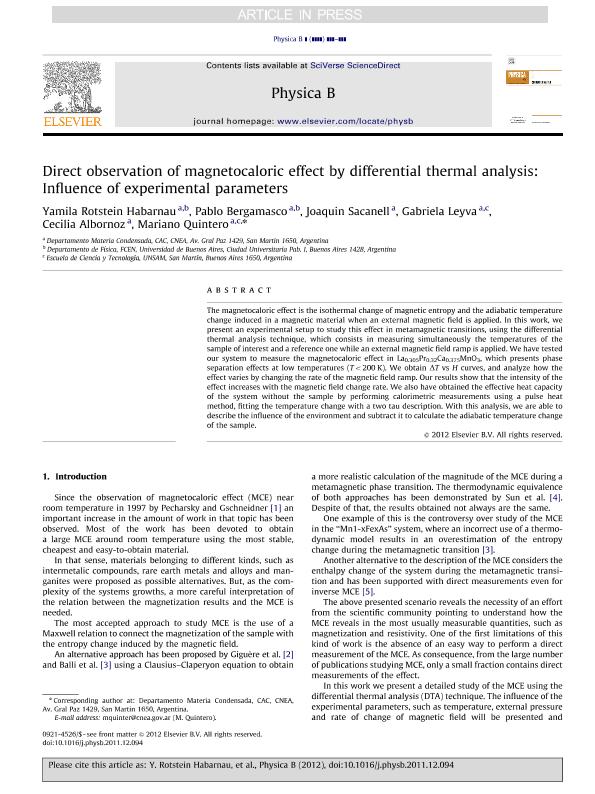Mostrar el registro sencillo del ítem
dc.contributor.author
Rotstein Habarnau, Yamila Valeria

dc.contributor.author
Bergamasco, Pablo
dc.contributor.author
Sacanell, Joaquin Gonzalo

dc.contributor.author
Leyva, Gabriela
dc.contributor.author
Albornoz, Cecilia
dc.contributor.author
Quintero, Mariano Horacio

dc.date.available
2023-04-20T11:05:49Z
dc.date.issued
2012-01
dc.identifier.citation
Rotstein Habarnau, Yamila Valeria; Bergamasco, Pablo; Sacanell, Joaquin Gonzalo; Leyva, Gabriela; Albornoz, Cecilia; et al.; Direct observation of magnetocaloric effect by differential thermal analysis: Influence of experimental parameters; Elsevier Science; Physica B: Condensed Matter; 407; 16; 1-2012; 3305-3307
dc.identifier.issn
0921-4526
dc.identifier.uri
http://hdl.handle.net/11336/194668
dc.description.abstract
The magnetocaloric effect is the isothermal change of magnetic entropy and the adiabatic temperature change induced in a magnetic material when an external magnetic field is applied. In this work, we present an experimental setup to study this effect in metamagnetic transitions, using the differential thermal analysis technique, which consists in measuring simultaneously the temperatures of the sample of interest and a reference one while an external magnetic field ramp is applied. We have tested our system to measure the magnetocaloric effect in La0.305Pr0.32Ca0.375MnO3, which presents phase separation effects at low temperatures (T < 200 K). We obtain ∆T vs H curves, and analyze how the effect varies by changing the external pressure and the rate of the magnetic field ramp. Our results show that the optimum conditions to measure the effect are at the lower pressures (< 10−4 Torr) and faster changes of the magnetic field. However, at very high vacuum, a temperature gradient appears and makes it difficult to set the temperature properly. Also, self-heating of the sensor becomes relevant at this condition, so care must be taken in order to establish the external conditions. We have obtained the effective heat capacity of the system without the sample by performing calorimetric measurements using a pulse heat method, fiting the temperature change with a two tau description. With this analysis, we are able to describe the influence of the environment and subtract it to calculate the adiabatic temperature change of the sample.
dc.format
application/pdf
dc.language.iso
eng
dc.publisher
Elsevier Science

dc.rights
info:eu-repo/semantics/openAccess
dc.rights.uri
https://creativecommons.org/licenses/by-nc-sa/2.5/ar/
dc.subject
Magnetocalorico
dc.subject
Calor
dc.subject
DTA
dc.subject.classification
Física de los Materiales Condensados

dc.subject.classification
Ciencias Físicas

dc.subject.classification
CIENCIAS NATURALES Y EXACTAS

dc.title
Direct observation of magnetocaloric effect by differential thermal analysis: Influence of experimental parameters
dc.type
info:eu-repo/semantics/article
dc.type
info:ar-repo/semantics/artículo
dc.type
info:eu-repo/semantics/publishedVersion
dc.date.updated
2023-04-19T14:55:22Z
dc.journal.volume
407
dc.journal.number
16
dc.journal.pagination
3305-3307
dc.journal.pais
Países Bajos

dc.journal.ciudad
Amsterdam
dc.description.fil
Fil: Rotstein Habarnau, Yamila Valeria. Universidad de Buenos Aires. Facultad de Ciencias Exactas y Naturales. Departamento de Física; Argentina. Consejo Nacional de Investigaciones Científicas y Técnicas; Argentina. Comisión Nacional de Energía Atómica; Argentina
dc.description.fil
Fil: Bergamasco, Pablo. Comisión Nacional de Energía Atómica; Argentina. Universidad de Buenos Aires. Facultad de Ciencias Exactas y Naturales. Departamento de Física; Argentina
dc.description.fil
Fil: Sacanell, Joaquin Gonzalo. Comisión Nacional de Energía Atómica. Gerencia del Área de Investigaciones y Aplicaciones no Nucleares. Gerencia de Física (Centro Atómico Constituyentes); Argentina. Consejo Nacional de Investigaciones Científicas y Técnicas; Argentina
dc.description.fil
Fil: Leyva, Gabriela. Comisión Nacional de Energía Atómica. Gerencia del Área de Investigaciones y Aplicaciones no Nucleares. Gerencia de Física (Centro Atómico Constituyentes); Argentina
dc.description.fil
Fil: Albornoz, Cecilia. Comisión Nacional de Energía Atómica. Gerencia del Área de Investigaciones y Aplicaciones no Nucleares. Gerencia de Física (Centro Atómico Constituyentes); Argentina
dc.description.fil
Fil: Quintero, Mariano Horacio. Comisión Nacional de Energía Atómica. Gerencia del Área de Investigaciones y Aplicaciones no Nucleares. Gerencia de Física (Centro Atómico Constituyentes); Argentina. Consejo Nacional de Investigaciones Científicas y Técnicas; Argentina
dc.journal.title
Physica B: Condensed Matter

dc.relation.alternativeid
info:eu-repo/semantics/altIdentifier/url/https://www.sciencedirect.com/science/article/abs/pii/S0921452611012877
dc.relation.alternativeid
info:eu-repo/semantics/altIdentifier/doi/http://dx.doi.org/10.1016/j.physb.2011.12.094
Archivos asociados
